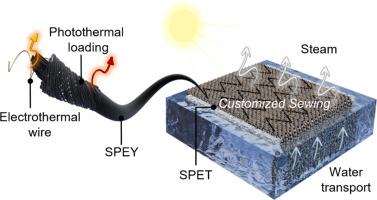Scalable sewing textiles with optimized electrothermal utilization for efficient all-day desalination
IF 8.1
1区 工程技术
Q1 ENGINEERING, CHEMICAL
引用次数: 0
Abstract
Solar steam generation (SSG) has been considered a promising technology to address the worldwide water crisis through desalination and condensation. However, the strong dependence on solar radiation leads to evaporation instability and discontinuity in evaporation rates. Hence, it is critical to develop sustainable electrothermal coupled solar steam generation (ESSG) systems and improve energy conversion efficiencies. Herein, a scalable sewing photo-electro-thermal textile (SPET) is customized to enhance energy utilization efficiency during each step of the electrothermal conversion process. Specifically, the moderate voltage input is manipulated to match evaporation energy requirements. Sewing patterns are modified to improve electrothermal conversion efficiency and thermal distribution uniformity. Hence, an outstanding ESSG rate of 2.43 kg m−2·h−1 is realized under 2 V DC input and 1 sun radiation. The daily condensate mass reaches about 19.8 L·m−2 during 30 days of desalination (continuous operation for 24 h per day) without salt accumulation or galvanic corrosion. Overall, SPET with rational electrothermal conversion, thermal distribution, and evaporation utilization efficiencies demonstrate continuous, durable, and efficient ESSG.

可伸缩的缝纫纺织品与优化的电热利用,高效的全天脱盐
太阳能蒸汽发电(SSG)被认为是一种很有前途的技术,通过淡化和冷凝来解决世界范围内的水危机。然而,对太阳辐射的强烈依赖导致蒸发不稳定和蒸发速率的不连续性。因此,开发可持续的电热耦合太阳能蒸汽发电(ESSG)系统,提高能量转换效率至关重要。在此,定制了一种可伸缩的缝纫光电热电纺织品(SPET),以提高电热转换过程中每个步骤的能源利用效率。具体来说,中压输入被操纵以匹配蒸发能量需求。修改缝纫图案以提高电热转换效率和热分布均匀性。因此,在2 V直流输入和1太阳辐射下,实现了2.43 kg m−2·h−1的出色ESSG速率。脱盐30 天(每天连续运行24 h),无积盐和电偶腐蚀,日凝结水质量约19.8 L·m−2。总体而言,具有合理电热转换、热分布和蒸发利用效率的SPET表现出连续、持久和高效的ESSG。
本文章由计算机程序翻译,如有差异,请以英文原文为准。
求助全文
约1分钟内获得全文
求助全文
来源期刊

Separation and Purification Technology
工程技术-工程:化工
CiteScore
14.00
自引率
12.80%
发文量
2347
审稿时长
43 days
期刊介绍:
Separation and Purification Technology is a premier journal committed to sharing innovative methods for separation and purification in chemical and environmental engineering, encompassing both homogeneous solutions and heterogeneous mixtures. Our scope includes the separation and/or purification of liquids, vapors, and gases, as well as carbon capture and separation techniques. However, it's important to note that methods solely intended for analytical purposes are not within the scope of the journal. Additionally, disciplines such as soil science, polymer science, and metallurgy fall outside the purview of Separation and Purification Technology. Join us in advancing the field of separation and purification methods for sustainable solutions in chemical and environmental engineering.
 求助内容:
求助内容: 应助结果提醒方式:
应助结果提醒方式:


